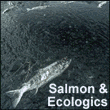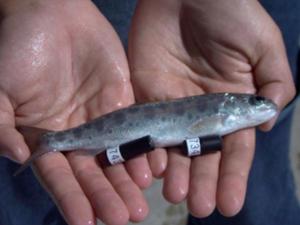forum
library
tutorial
contact

Biodiversity: Unraveling the
Mysteries of Salmon Migration
by By Stephen LeahyScience Daily, October 31, 2008
|
the film forum library tutorial contact |

|
Biodiversity: Unraveling the
by By Stephen Leahy |
Similar Survival Rates For Pacific Salmon In Fraser And Columbia Rivers
 UXBRIDGE, Canada - Tiny juvenile salmon have been electronically tracked for the first time from their natal rivers in the Rocky Mountains 2,500 kilometres north to Alaska.
UXBRIDGE, Canada - Tiny juvenile salmon have been electronically tracked for the first time from their natal rivers in the Rocky Mountains 2,500 kilometres north to Alaska.
"We're turning the lights on in the oceans," enthused Jim Bolger, a marine biologist at the Vancouver Aquarium.
"It's very exciting, with this new technology scientists can finally see how changes in the oceans are affecting fish and other species," Bolger told IPS.
The new technology is a series of electronic acoustic receivers planted along the ocean bottom stretching 1,750 kilometres from Oregon through British Columbia and north to the Alaskan panhandle. Fish and other species have transmitters implanted and the receivers pick up their individual signals as they pass.
The transmitters or tags are now as small as an almond and can be surgically implanted in juvenile salmon less than 14 centimetres in length. As they approach, the receivers log the tag's unique serial number, the date and time. Movement patterns of individual animals, including direction and speed, can be reconstructed using the time of detection at different receivers and other listening curtains.
"Several mysteries of fish migration and survival may soon start to unravel," said Bolger, the executive director of what is called the Pacific Ocean Shelf Tracking (POST) Project, a part of the international Census of Marine Life
One of those mysteries is where salmon go after they leave the rivers where they are born.
To try and answer that question, researchers implanted tags in 1,000 juvenile Chinook salmon in 2006 and followed their journeys in the Columbia and Fraser Rivers using the POST receivers. Among the many studied, two tagged juveniles survived a 2,500-km trip that took more than three months -- from the upper reaches of the Snake River (a tributary of the Columbia River) in Idaho, out to sea then north along the continental shelf to Alaska according to a study published this week in the journal Public Library of Science Biology,
Most surprising of all, said Bolger, was that salmon from the undammed, free-flowing Fraser River in Canada suffered the same high levels of mortality as those battling their way through the eight dams of the Columbia River system. In fact, more survived in the Columbia once distance or travel time was taken into account -- and survival was greater during migration within the hydropower system than below the dammed section.
"It raises the question of unknown factors in the Fraser system that may be having an impact on the juveniles," said Bolger, one of the co-authors of the study.
Results of previous studies on white sturgeon also surprised researchers when they learned that the big, bottom-feeding fish migrated from the Sacramento River in California to the Fraser nearly 1,000 kms north in Canada.
"We thought the Fraser sturgeon were local and that it was okay to fish them," Bolger said. In the U.S., they are carefully regulated but no one knew they migrated into Canada.
"Wherever future research leads on those questions, the electronic and acoustic technology has demonstrated itself as a useful tool for obtaining unique scientific data of importance in a number of public policy arenas," said David Welch of Kintama Research, Nanaimo, British Columbia who led the salmon research effort.
Similar electronic listening curtains will have been strung together along the northeast coast by the end of this year. Two others being considered are between Florida and Cuba and another between Mexico's Yucatan Peninsula and Cuba. The hope is to cover much of the world's continental shelf one day, said Jesse Ausubel of Rockefeller University, who is a member of POST's management board.
"We have a working technology, and it's affordable. The hope is to have a monitoring system around the world," Ausubel told IPS.
This type of tracking network can reveal the mysteries about where fish go and how many survive in the oceans, and can help fisheries management and conservation efforts. There are enormous controversies along the coastal zones of Africa and other places about which country "owns" certain fish stocks, he said.
"Knowing where fish go is a key question that needs to be answered," Ausubel said.
And knowing where species migrate, feed and breed is vital for conservation and management efforts. Within the next decade Ausubel hopes there will be an Ocean Tracking Network that covers continental shelves as well as the open ocean.
A different tracking device is needed for fish like sharks that traverse entire oceans. The open ocean tag is a like a business card -- it not only identifies the specific fish, it records all sorts of data about where it has been and data from any other tagged fish that were nearby. That way when any of the fish are close enough to a floating receiver, all this information will be downloaded. For species that break the surface, the data will be transferred via satellite.
The first of these new tags will be implanted in salmon sharks near Hawaii in 2009. If all goes well, scientists will be able to determine their migration route to the Gulf of Alaska. And with salmon also tagged, there might be the first real-time study of the predator-prey interactions, Ausubel said.
"These results from North America have global implications and will be of interest in Chile, Russia, Japan, India, Ireland -- indeed every nation where fish migrate between fresh and salt water," concluded Victor Gallardo of Chile, the Census of Marine Life's vice chair.
Related Pages:
Biodiversity: Unraveling the Mysteries of Salmon Migration
by Stephen Leahy, Science Daily, 10/31/8
Do Dams Make A Difference?
IPS News, 10/30/8
Salmon Study Yields Surprise Result
by Jeff Barnard,
Capital Press, 10/30/8
Readers Discuss POST article
by Reader Discussion,
The Oregonian, 10/29/8
Salmon: No Dam Difference?
by Editorial Board,
The Oregonian, 10/29/8
Track the Salmon in California
by Editorial Board,
Contra Costa Times, 10/29/8
New Study Finds Fish Do as Well on Dammed Rivers
by Editorial Board,
Walla Walla Union-Bulletin, 10/29/8
Dams Appear to Have No Impact on Salmon
by Michael Reilly,
Discovery News, 10/29/8
Salmon Smolt Survival Similar in Columbia and Fraser
by Mark Floyd,
Eureka Alert, 10/27/8
Salmon Study Under Fire for Minimizing Effect of Dams
by Warren Cornwall,
Seattle Times, 10/27/8
Research Hints Dam Improvements Helping Salmon
by Michael Milstein,
The Oregonian, 10/27/8
Dams Not Main Cause of Salmon Collapse, Study Says
by James Owen,
National Geographic News, 10/27/8
Study Shows More Salmon Survive West's Dammed Rivers
Canadian Press, 10/27/8
Radio Tags Shed Light on Salmon Migration Routes
by Mark Hume,
Globe and Mail, 10/27/8
learn more on topics covered in the film
see the video
read the script
learn the songs
discussion forum
